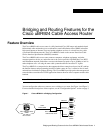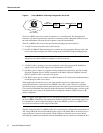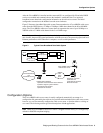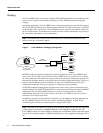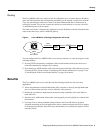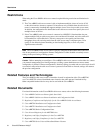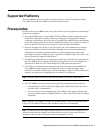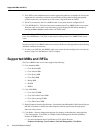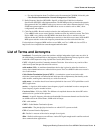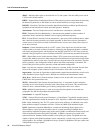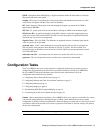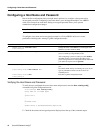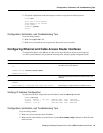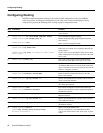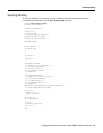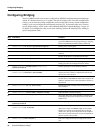
List of Terms and Acronyms
Bridging and Routing Features for the Cisco uBR924 Cable Access Router 9
— For more information about CiscoWorks on the Documentation CD-ROM, follow this path:
Cisco Product Documentation: Network Management: CiscoWorks
• Radio Frequency Interface (RFI) MIB—Specific to Data-Over-Cable Service Interface
Specification (DOCSIS) cable implementations. The RIF MIB provides an interface that permits
management of the Cisco uBR924 cable access router over the cable or Ethernet interface. Using
SNMP management applications, this MIB allows access to statistics such as MAC, driver
configuration, and counters.
• Cable Device MIB—Records statistics related to the configuration and status of the
Cisco uBR924 cable access router. Statistics include an events log and device status. The Cable
Device MIB is very similar to the RFI MIB in that both allow access to statistics; they are
different in that the Cable Device MIB reports statistics on the cable access router, while the RFI
MIB reports statistics on the radio frequency transmissions over the cable television line.
For descriptions of supported MIBs and how to use MIBs, see Cisco’s MIB web site on CCO at
http://www.cisco.com/public/sw-center/netmgmt/cmtk/mibs.shtml.
List of Terms and Acronyms
broadband—Transmission system that combines multiple independent signals onto one cable. In
the cable industry, broadband refers to the frequency-division multiplexing of many signals in a wide
bandwidth of RF frequencies using a hybrid fiber-coaxial (HFC) network.
CATV—Originally stood for Community Antenna Television. Now refers to any coaxial or fiber
cable-based system that provides television services.
cable modem (CM)—A modulator-demodulator device that is placed at subscriber locations to
convey data communications on a cable television system. The Cisco uBR924 cable access router is
also a cable modem.
Cable Modem Termination System (CMTS)—A termination system located at the cable
television system headend or distribution hub which provides complementary functionality to the
cable modems, enabling data connectivity to a wide-are network.
cable router—A modular chassis-based router optimized for data-over-CATV hybrid fiber-coaxial
(HFC) applications.
carrier—A signal on which another, lower-frequency signal is modulated in order to transport the
lower-frequency signal to another location.
Carrier-to-Noise—C/N (also CNR). The difference in amplitude between the desired RF carrier
and the noise in a portion of the spectrum.
channel—A specific frequency allocation and bandwidth. Downstream channels used for television
are 6 MHz wide in the United States; 8 MHz wide in Europe.
CM—cable modem.
CMTS—Cable Modem Termination System.
coaxial cable—The principal physical media over which CATV systems are built.
CPE—Customer Premises Equipment
dB—Decibel. A measure of the relative strength of two signals.
dBm—Decibels with respect to one milliwatt. A unit of RF signal strength used in satellite work and
other communications applications.



